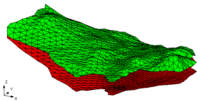GMS:Editing a TIN: Difference between revisions
From XMS Wiki
Jump to navigationJump to search
No edit summary |
|||
| Line 1: | Line 1: | ||
{{TIN links}} | {{TIN links}} | ||
TINs can be edited several ways. The selection and editing tools apply only to the active TIN. If | TINs can be edited several ways. The selection and editing tools apply only to the active TIN. If going to edit vertices, the user must first turn off the ''TINs'' | '''Lock All Vertices''' menu command. | ||
==Editing TIN Vertices== | ==Editing TIN Vertices== | ||
===Creating New TIN Vertices=== | ===Creating New TIN Vertices=== | ||
New vertices can be created using the '''''Create Vertices''''' tool from the [[GMS:TIN Tool Palette|TIN Tool Palette]]. Clicking in the Graphics Window creates a new vertex at the point clicked (vertices can only be created when in | New vertices can be created using the '''''Create Vertices''''' tool from the [[GMS:TIN Tool Palette|TIN Tool Palette]]. Clicking in the Graphics Window creates a new vertex at the point clicked (vertices can only be created when in '''Plan View'''). The default z value and other parameters governing the creation of new vertices can be set by selecting the '''TIN Settings''' command from the ''TINs'' menu. | ||
===Deleting TIN Vertices=== | ===Deleting TIN Vertices=== | ||
Selected TIN vertices can be deleted by hitting the | Selected TIN vertices can be deleted by hitting the ''Delete'' key or by selecting the '''Delete''' command from the ''Edit'' menu. If the '''Confirm Deletions''' option in the [[GMS:Preferences|''Preferences'']] dialog is on, the user is prompted to confirm each deletion. | ||
===Editing TIN Vertex Coordinates=== | ===Editing TIN Vertex Coordinates=== | ||
Two methods of editing TIN vertex coordinates are available. To manipulate vertex coordinates, the | Two methods of editing TIN vertex coordinates are available. To manipulate vertex coordinates, the '''Select Vertex''' tool must be selected from the [[GMS:TIN Tool Palette|TIN Tool Palette]]. | ||
*A vertex can be moved to a new position by clicking on the vertex and holding down the mouse button while dragging the vertex to the desired position. If the current view is plan view, dragging the vertex causes it to move in the xy plane. GMS does not allow the vertex to be dragged to a position where one of the surrounding triangles becomes inverted. If the current view is not the plan view, the vertex moves along the z-axis. | *A vertex can be moved to a new position by clicking on the vertex and holding down the mouse button while dragging the vertex to the desired position. If the current view is plan view, dragging the vertex causes it to move in the xy plane. GMS does not allow the vertex to be dragged to a position where one of the surrounding triangles becomes inverted. If the current view is not the plan view, the vertex moves along the z-axis. | ||
| Line 35: | Line 35: | ||
===Subdivide TIN=== | ===Subdivide TIN=== | ||
This command can be used to "smooth" a TIN. When using a TIN for contouring, the contours are computed using a linear interpolation of the triangles. If the vertices are sparse, the contours may not appear to be smooth. The contours can be smoothed by copying the vertices to a scatter point set, subdividing the TIN into sub-triangles, and interpolating the z values (or other | This command can be used to "smooth" a TIN. When using a TIN for contouring, the contours are computed using a linear interpolation of the triangles. If the vertices are sparse, the contours may not appear to be smooth. The contours can be smoothed by copying the vertices to a scatter point set, subdividing the TIN into sub-triangles, and interpolating the z values (or other datasets) from the scatter point set to the new vertices defining the sub-triangles. | ||
Subdivision and smoothing can be accomplished using the following steps: | Subdivision and smoothing can be accomplished using the following steps: | ||
